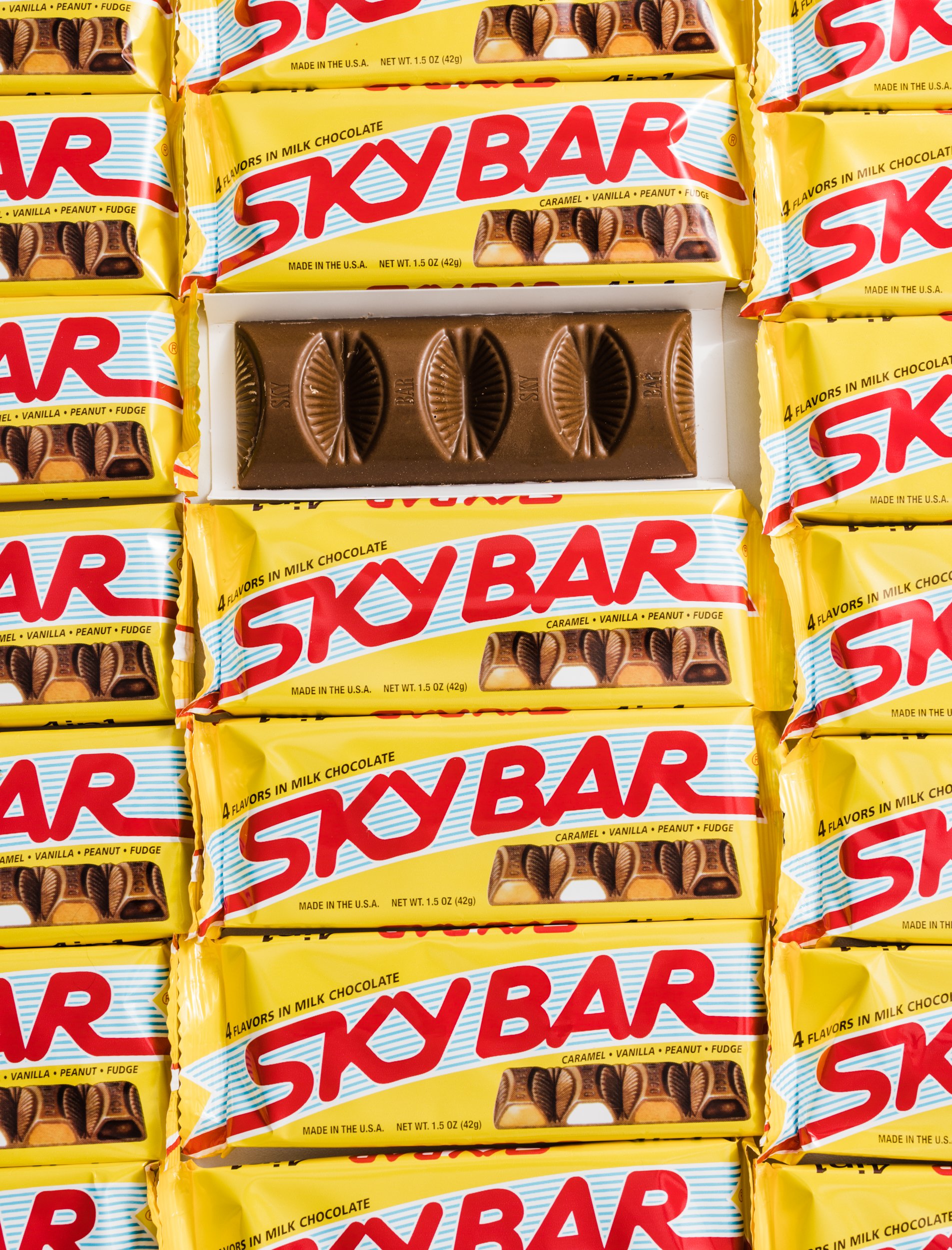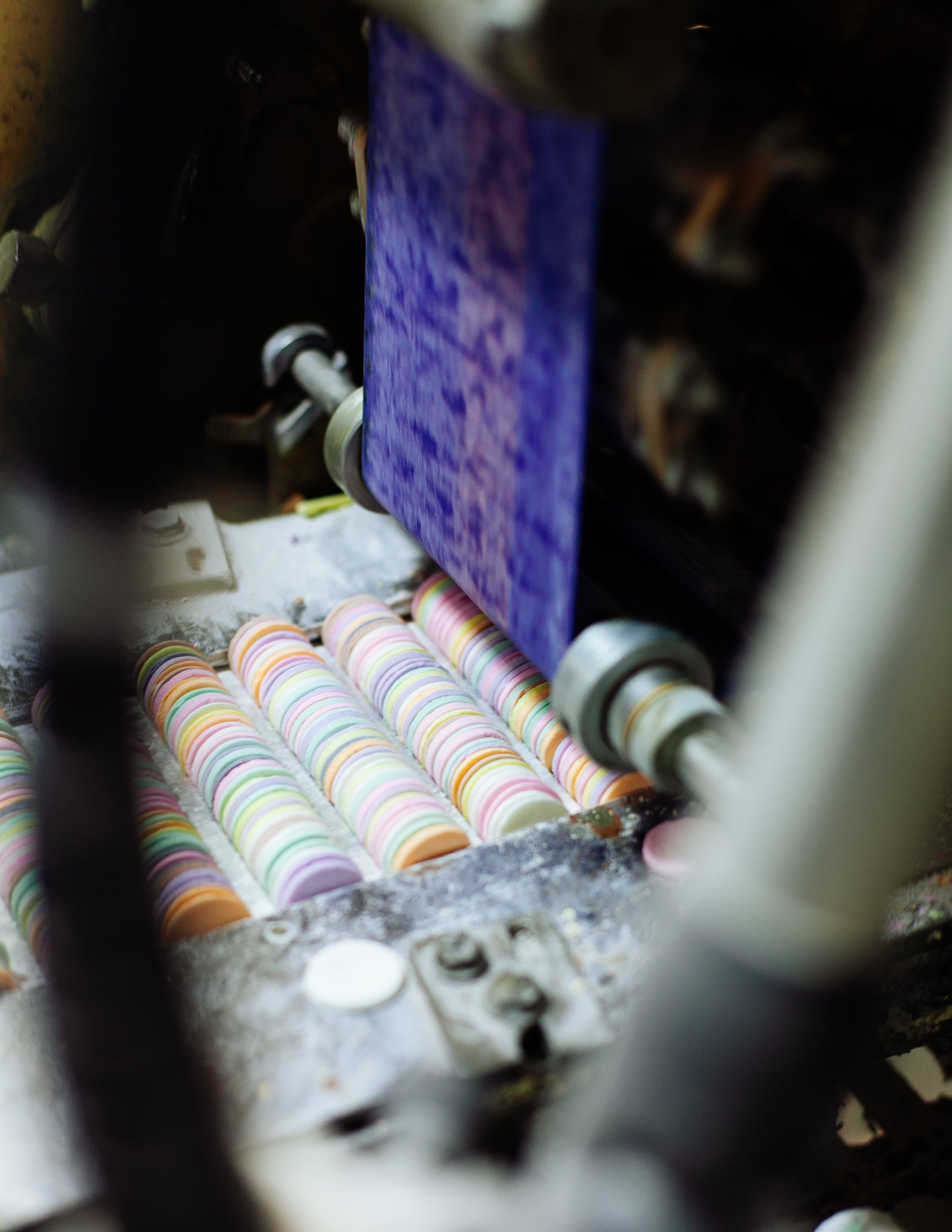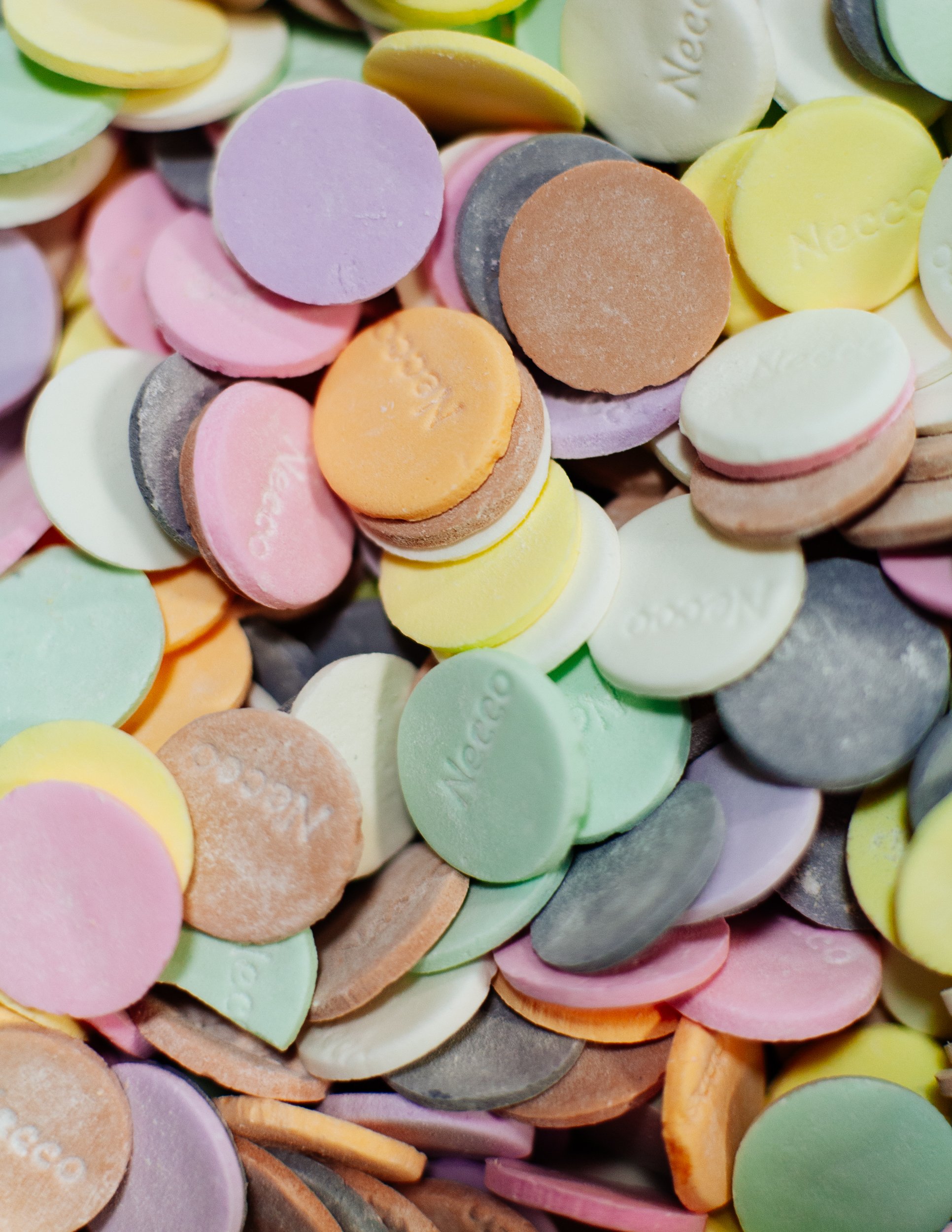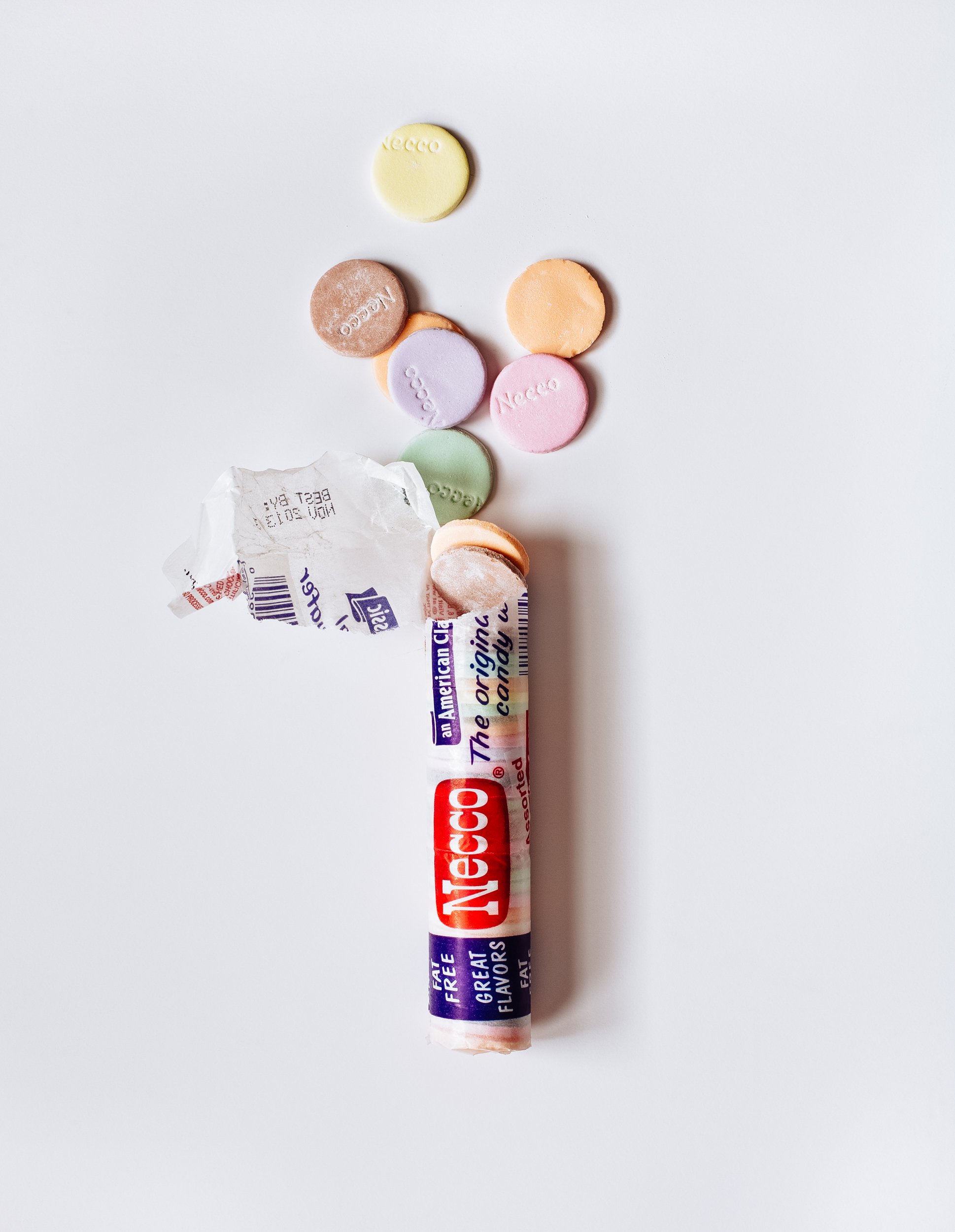As Sweet Taste of History: Cambridge’s Candymaking History Continues Beyond Confectioner’s Row
Photos by Michael Piazza
The picture is the stuff of Kendall Square legend: A handsome young inventor stands at his workbench toiling on a new device that’s about to revolutionize an industry, and make this Cambridge neighborhood an important hub for the next century.
The year is 1847. And the artist’s idyllic vision, painted in sepia and cream tones, is of druggist Oliver Chase hard at work on a “curious, homemade apparatus that looked like a clothes wringer with a series of holes cut in the rollers.”
The important industry Chase is about to set in motion: candymaking.
The illustration of the inventor at work comes from a history book published in 1947 that celebrates the New England Confectionery Company—or Necco—the candy empire built by Chase and others. The Boston area was the birthplace of commercial candymaking in America. It was given its boost by Chase’s invention.
The section of Main Street in Cambridge between Kendall and Central Squares—now filled with pharmaceutical offices, life science labs, university buildings and condos— was once known as Confectioner’s Row. It was ground zero for the region’s candymaking industry. And Necco’s massive facility on Massachusetts Avenue was its anchor.
Necco Wafers, Charleston Chew, Junior Mints, Sugar Babies, Conversation Hearts, Fig Newtons and Sky Bar were all born on or near Confectioner’s Row. So were other American classics, and dozens of long-forgotten candies such as Mr. Chairman, Whangbees and Zoo Jokers.
Several of the candies are still made on Main Street in the last remaining factory owned by Cambridge Brands, part of Tootsie Roll Industries. According to a 2018 Boston Globe article, about 200 people work at the Cambridge Brands factory and produce 26.5 million pieces of candy a day. The company is notoriously publicity shy—the facility is strictly off limits to the public and few outsiders are allowed inside. But the smell of chocolate and mint lets you know the factory is still doing its thing. The article quotes a statement from the company saying the Main Street factory is the world’s only source of Junior Mints, Sugar Babies and Charleston Chews.
After Necco went bankrupt in 2018, another beloved brand, Sky Bar, has found a new lease on life and is also being manufactured locally—in Sudbury—by its new owner, Louise Mawhinney. Most other candies have been scattered by corporate winds to various manufacturers around the country.
Historically, Boston, Cambridge and Somerville have been home to some 140 candy manufacturers. At the industry’s peak in 1946, the Cambridge phone book listed 66 candy manufacturing companies. In 1965, local factories produced $188 million worth of candy (about $1.6 billion in current dollars.)
When Oliver Chase kicked things off in 1847, he worked in both the apothecary and confectionery industries, a pairing that might sound odd today. But in the mid 19th century, the two went hand-in-hand. Confectioners created the candy coatings that quite literally helped the medicine go down. When he invented and patented what would become the first American candymaking machine—that clotheswringer- like contraption—Chase was looking to increase the speed and precision of making the candy lozenges that he manufactured from gum Arabic, peppermint and brown sugar, and sold to druggists.
The candy disks Chase’s machine produced were “the great-great-grandfather” of the Necco Wafer. Chase and his brothers—one of whom figured out how to print on Oliver’s candy disks to create Sweethearts Conversation Hearts—founded Chase and Company in Boston. Eventually their company joined with other Boston candy pioneers Ball and Fobes, who introduced Turkish Delight and mocha to American tastes, and Bird, Wright and Company who specialized in gumdrops and other candies popular with children, to create the New England Confectionery Company.
“Necco was formed in 1901 as an amalgamation of three already successful companies. They were really big. Much bigger than I ever had imagined,” says Darlene Lacy, author of Necco: An Epic Candy Tale, which traces the long rise and fall of the Necco empire.
“They spent $300,000 on the facility in 1901. They started rolling out over 500 varieties of candies. They had hundreds of workers. Off and on over the decades, these people were working around the clock,” according to Lacy.
When the three companies came together, their first factory was on Congress Street in South Boston. Necco moved to its state-of-the-art Cambridge location in 1927. “It was considered a monument to modern architecture and industrial technology,” Lacy says.
The Cambridge Tribune described the factory opening as a “landmark in the history of the city” and dubbed it “the largest candy manufactory in the world.” The paper further lauded the company by saying: “The New England Confectionery Company came to the city and established more firmly its reputation as a great candy center of the universe.”
Lacy, who is a lifelong lover of candy memorabilia and curator of the online Candy Wrapper Museum, spent three years chronicling Necco’s history and published her book last year. The project began in 2018 when she received a phone call from a Necco executive as the company was going out of business. He asked if Lacy was interested in a company scrapbook that was taking up space in his basement. She jumped at the chance.
“I was picturing something like a high school notebook. But it was two feet high, four feet wide. It looked like something from Harry Potter or the Munsters,” she says.
The book was filled with candy wrappers, packages, advertising, ephemera, recipes and formulas dating back to the 1800s. She began scanning, photographing and transcribing the materials and ultimately had enough to produce two books. Along the way she compiled a list of 1,380 Necco- brand candies that were created over the years as the company grew and acquired other companies.
“They were much, much more than Necco Wafers or Sky Bar,” she notes.
Another person working to keep the area’s candy history alive is confectioner Jeremy Spindler, who has created a museum of regional candy memorabilia at Spindler Confections. In his shop outside Porter Square in Cambridge, Spindler makes and sells handmade chocolates, bonbons, barks and more amidst a collection of some 100 candymaking artifacts.
“We were looking on eBay just for kicks. We came up with the idea that since there was all this history in the area, and we were starting the shop, let’s start collecting this stuff. We can decorate the shop and put in a little museum,” Spindler says.
Spindler, who was an academic before he began making and selling homemade caramels in 2012, doesn’t just collect memorabilia, but researches and documents local candymaking history. “It’s a fascinating history and a really fun history too,” Spindler says.
Spindler’s museum envelopes the cozy customer area of his shop—original molds from Donna Deane Chocolates in Boston, a shipping label for Baker’s Chocolate Breakfast Cocoa, a full wall of chocolate packages representing many eras and occasions from local favorites like Schrafft’s, Candy Cupboard, and Page and Shaw. Showing off pieces from his collection with elegant Asian and Art Deco designs, Spindler notes that manufacturers might design 10 or more elaborate boxes for Christmas, then 10 more for Valentine’s Day.
Skimming through a 1924 Page and Shaw publication, Spindler reflects on the former industry. “The scale was unreal. Giant chocolate presses. Women hand-packing chocolates. I don’t think I would want to have lived during that time. But I’d love to go back for a week and just see how crazy everything was, and smell what it was like to walk down Main Street,” Spindler says.
One of his rarest finds is a bronze-cast sign that hung outside the Necco complex in Revere, where the company moved production after selling its Cambridge headquarters to Novartis in 2004. “I want to believe that this adorned the original factory and it moved with them from place to place. But I have absolutely no evidence of that happening,” Spindler says.
Following the collapse of Necco in 2018, Louise Mawhinney came into possession of an even rarer piece of candymaking history. The owner of Duck Soup, a gourmet shop and general store in Sudbury, Mawhinney became the new owner of Sky Bar following a final auction of Necco assets. Sky Bar was one of the company’s signature candies, a milk chocolate bar with four different fillings: caramel, vanilla, peanut and fudge.
As Mawhinney tells it, she heard on the news that no one had stepped forward to buy Sky Bar on the first day of the asset auction. “It was astonishing to me,” she says, but noted that she didn’t give it much more thought.
“The morning of the final day of the auction, I walked my dogs. I came back and made myself a cup of coffee. It was about 8:30 in the morning and an email popped up from one of my customers, who was a Sky Bar fan, with a link to the auction. The rest is history: I clicked on a link, bid on Sky Bar and, to my shock and horror, I became the owner,” she says.
While she had been considering new options for her company, Mawhinney says her primary interest in continuing the brand was because “I’m a sentimentalist. Through Duck Soup, I knew that Sky Bar was very, very important to people in New England.”
Mawhinney spent much of 2019 ramping up to begin production of the candy. Some things worked in her favor: The space next to Duck Soup became available as a manufacturing location, and Necco’s former director of research and development offered to help a newbie navigate the process. Other parts were more challenging.
“We found out the reason no bona fide candy manufacturer wanted anything to do with Sky Bar is that it’s incredibly hard to make. It’s got four completely different fillings, all of which have to be the same viscosity and temperature in order to not burst out of the bar,” Mawhinney says. Armed with a collection of recipes dating back to the 1930s, the original Sky Bar molds and brand new manufacturing equipment, her team began making the candy in November 2019.
The current Sky Bar production operation consists of “two massive pieces of high speed equipment” and a team of four to five workers who produce enough candy to fill orders from specialty retail customers in New England. The potential exists to grow the operation.
Mawhinney, who grew up in Scotland, says she’s been surprised and touched with the reception she’s gotten from Sky Bar fans in New England and beyond.
“I was a little nervous telling people that I bought Sky Bar. I didn’t grow up with it. I’m a little upstart with no experience, and what nerve did I have? But that was not the reaction. Overwhelmingly, people were just so grateful that I kept it going. I had people call up crying on the phone. I had people come in and hug me. During lockdown, I had a man who for his 70th birthday, he and his wife drove up from Alabama just to see where Sky Bars were being made,” she says.
In its heyday, Confectioner’s Row candy manufacturers were highly competitive and kept their trade secrets under wraps. Mawhinney, however, is happy to share a peek into candymaking history at her Sky Bar production facility. “We put in big viewing windows to hopefully inspire the next generation of inventors in Sudbury,” she says.
Here’s hoping the next Oliver Chase is finding some sweet inspiration right now.
skybarcandy.com
spindlerconfections.com
This story appeared in the Spring 2023 issue.






